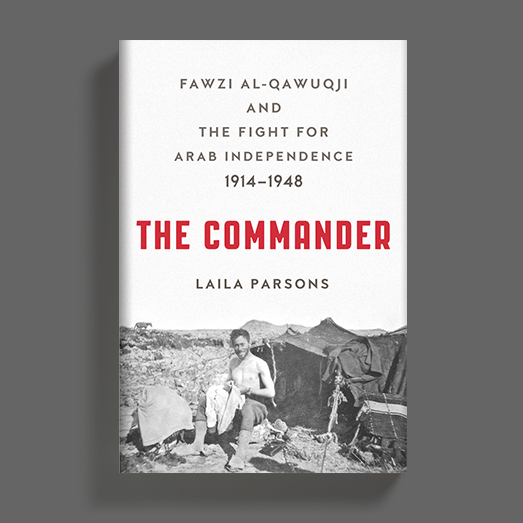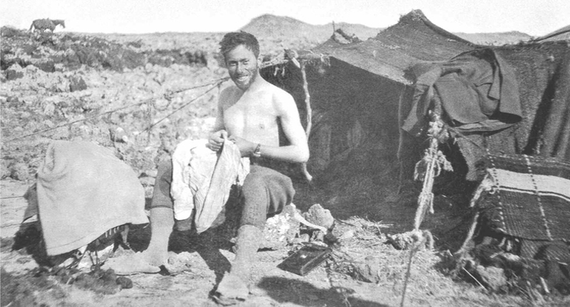By Laila Parsons
1
OTTOMAN OFFICER
An Arab cadet in Istanbul—Posting in Mosul—From the Iraqi front to the Palestinian front—Reconnaissance and the Iron Cross—German officers and Jamal Pasha—The Arab Revolt—Retreat and famine
"I opened my eyes to the world and found myself in the Ottoman military school system." This sentence opens Fawzi al-Qawuqji's memoirs. Childhood games with his brothers, Qadri, Zafir, Yumni, and Bahjat, and his sisters, Fawziyya and Badriyya, in the alley outside his home; the smells of his mother's cooking; visits to the family's orchard of orange and lemon trees; glimpses of the small religious college where his great-grandfather the scholar Abu al-Muhassin al-Qawuqji used to teach; eating special sweets with his father on a trip to Libya: none of these memories is mentioned in his self-narrative. He saw himself as the product of Ottoman military education.
This was understandable. Qawuqji's father, ʿAbd al-Majid al-Qawuqji, had served in the Ottoman Army, as did some of Qawuqji's brothers, including his younger brother Yumni, with whom Qawuqji was particularly close. ʿAbd al-Majid and his wife, Fatima al-Rifaʿi, raised their children in a simple house on a small alley in the Attarin district of the Arab port city of Tripoli, in today's Lebanon. They did not have the means to send their sons to the elite Ottoman civil school system. That system was reserved for the children of landowners or important merchant families. The military school system was free, and families with little income saw it as a practical way to ensure that their sons were educated and provided with a profession. The Qawuqjis were typical of military families in the late-nineteenth-century Ottoman Empire: neither wealthy nor poor, they were part of a respectable lower-middle-class Arab Sunni community in Tripoli.
AN ARAB CADET IN ISTANBUL
Qawuqji underwent officer training at the War College in Istanbul in the early 1900s. The Ottoman government had introduced the new military school system decades earlier, in the mid-nineteenth century. By the early 1900s thousands of boys from all over the Ottoman Empire had attended their local military school for free, and a select few, like Qawuqji, went on to train as officers in the War College itself. The military schools were expanded by the Ottoman sultan Abdul Hamid II, who saw them as a crucial element in his plan to modernize the institutions of the Ottoman state. In the 1890s, during a state visit to Washington, D.C., Sultan Abdul Hamid presented the American government with a gift, a series of albums containing photographs of the Ottoman Empire. The albums highlighted the Ottoman government's modernization drive, with photographs of new hospitals, factories, mines, harbors, railway stations, and government buildings. The albums also contained hundreds of photographs of the military schools. Some were exterior shots of the school buildings, which were nearly all neoclassical in style. Others showed cadets at drill practice on the training grounds of the schools, officer instructors in their classrooms, and dining tables laid for dinner.
The military schools depicted in the albums ranged across the Ottoman Empire, from Istanbul itself, to Van in eastern Anatolia, to Damascus and Baghdad in the Arab provinces of the empire, all the way to Sanʿa in Yemen. The War College in Istanbul took pride of place. Another photograph shows officers and cadets gathered in front of the War College in the early 1890s. Taken by a photographer from Istanbul's Abdullah Frères Studio, it captures the self-confidence that these men felt about their future in the Ottoman Army.
For Qawuqji and the other cadets, daily life in the War College was highly regimented. He spent his nights on a raised bed in a long gallery with dozens of other boys, listening to the horns of steamships moving slowly up the Bosphorus just half a mile from the windows of his dormitory. In the mornings he washed and dressed himself in his formal cadet's uniform, stiff wool trousers and a frock coat with a high collar. At mealtimes he ate with the other cadets in a vast dining room, on raised tables laid with separate plates and knives and forks. Meals were simple—stewed beans, mutton, rice—except during Ramadan, when special dishes were prepared and Ramadan sweets were handed out. His days were punctuated by the rhythm of daily prayers in the mosque that sat inside the walls of the college. But he spent most of his waking hours sitting at a wooden desk, facing a blackboard, and learning the standard military curriculum, taught either by a staff officer or by a religious scholar (ʿalim). His classes were conducted mainly in Ottoman Turkish and included oratory, theology and ethics, military theory, and history, as well as German and French.
Paintings of military heroes lined the walls of his classroom: a picture of Mehmet the Conqueror, the Ottoman sultan who captured Constantinople from the Byzantine Empire in 1453, hung next to portraits of Napoleon and Bismarck. Each classroom also had an official military map showing the Ottoman Empire stretching from the Balkans in the northwest to Mesopotamia in the east, to Egypt, Sudan, and the Arabian Peninsula in the south. The great metropolis of Istanbul, home of the War College itself, lay at the center of these maps. Often the maps did not reflect the true extent of Ottoman territorial control. Much of the Balkans was lost by the end of the nineteenth century, and Egypt was now ruled by the British, who pushed every day against the borders of the empire. Many cadets knew that the cartographic representation in their classroom differed from the reality on the ground, where the Ottoman Empire was increasingly besieged by French and British assaults. Some maps also included the empire's new communications infrastructure then under construction, particularly the telegraph and the railway that by the early 1900s could take you from Istanbul to Ankara and Konya in central Anatolia and all the way to Damascus. Four hundred miles of new line pushed south from Damascus toward the holy cities of the Hijaz, and a branch line connected Damascus and Haifa.
Cavalry practice took Qawuqji outside the classroom into the hills just outside the city. Young cadets normally trained with decades-old Mauser rifles from Germany, although they were not allowed to use live ammunition. The few Ottoman cadets sent off to Germany came back with stories of different training practices. Everything in Germany was elaborately and precisely organized, and German cadets trained in battle scenarios using the latest model of the Mauser loaded with live ammunition. German cadets also ate good food in ornate dining rooms, wore uniforms made of fine cloth, and danced with pretty girls in elegant ballrooms.
Sign up for more essays, interviews and excerpts from Thought Matters.
ThoughtMatters is a partnership between Macmillan Publishers and Huffington Post
The Ottoman cadets' sense that emulating such European practices put them in the vanguard deepened as they moved through their days sleeping on raised beds, eating at raised tables, and studying German and French at raised desks set in rows. These experiences set the cadets apart from most other Ottoman subjects. Other aspects of Qawuqji's daily life remained familiar from his childhood in Tripoli: the food he ate, the prayers he attended, and the classes he took in theology and ethics, grounded in the rich traditions of Islamic learning.
The stone neoclassical building of the War College stood on a hill overlooking the Bosphorus. The barracks of Tashkishla, which served as the city's garrison, lay to the south of the college. Abdul Hamid's walled palace lay to the north, and the cadets could see the older palaces and gardens of Dolmabahce and Chiragan on the shore of the Bosphorus below. The bars and restaurants of the European district of Beyoglu were within walking distance, as was the harbor area of Galata, whose side streets were famous for their beer halls and brothels worked by Christian prostitutes.
Cadets often sneaked out for a night on the town, avoiding detection by one of the college monitors lest they lose points on the sections of their report cards labeled "Moral Conduct." The cadets moved past public buildings built in the same neoclassical style and with the same dressed stone as the college itself: the railway station at Haydarpasha, the customs office at the port where the steamships docked, and Abdul Hamid's new municipal buildings. This gave them a sense of the empire's new direction.
The cadets at the War College were almost all Sunni Muslims, from every province of the Ottoman Empire. In his memoirs Qawuqji speaks of his Arab, Turkish, Albanian, and Circassian peers, all of them looking up to the Ottoman sultan as their leader. They shared a firm sense of being part of a new class of Ottoman soldiers who would spend their professional lives in the Ottoman Army. But social hierarchy did exist. In some cases the teachers treated the Turkish-speaking cadets from Istanbul and Anatolia with greater respect than the Arabic-speaking cadets from the Arab provinces of the empire. Although Qawuqji does not mention it in his memoirs, he complained in later years that certain cadets were served better food than he was. When he asked why, he was told that it was because they were Turks and he was an Arab.
During 1908 and 1909 Qawuqji's vague sense of social difference started to connect with the turbulent politics in Istanbul. In 1908 the constitutionalists, the so-called Young Turks, took power from Abdul Hamid II, who was committed to reforming the infrastructure but not the principle of the direct rule of the sultan. The Young Turks were a group of progressive medical students and military cadets. Their movement stemmed from previous reform-minded groups, which had been driven underground after Abdul Hamid abolished the new Ottoman constitution in 1878. They wanted to replace the system of absolute monarchy with a constitutional monarchy. Many of them also rejected the Ottoman character of the empire, focusing instead on the use of specifically Turkish symbols to build a new Turkish-centered nationalism.
Qawuqji was startled that some of his teachers heralded the overthrowing of Abdul Hamid as the beginning of a new era:
I was getting on with the business of going from class to class when suddenly one day an officer came rushing in, all agitated, and shouting, "The army of freedom has entered Istanbul and freedom and justice and equality and fraternity are declared in the State!" I laughed to myself and wondered: What is the army of freedom? And what happens when it enters Istanbul? And what does freedom mean? Was it lost and have we suddenly found it? The officer kept talking at us in this way, and we listened to him as if we were listening to a lecture on Arabic literature given in Chinese by a Chinese professor.
Political events crashed through the walls of the college into Qawuqji's world. By his own account, he now began to see differences between Arabs and Turks. After 1908 Qawuqji started hearing of the formation of secret Arab organizations. He noticed that the Turkish students seemed to feel connected to one another through what he calls a new bond. This new bond differed from the older, looser connection that the Turkish students had previously felt to other Ottoman subjects. To illustrate his point, Qawuqji tells the story of a fight between a group of Turkish soldiers and a group of Arab soldiers:
I heard one of them saying with great enthusiasm and seriousness, "I am Turkish," and the other replying immediately with pride, "I am Arab," and the Arab students rushed to support their colleague. And it was as if this moment of truth, which was released into the skies above the War College, had put an end to the bond that had tied us to the Ottoman state. From that moment we began to feel that we had an independent Arab nation and that behind it were a community and a history and a time-honored glory.
Political identities are not formed overnight. This young Arab cadet had many years of bloody fighting ahead of him defending the Ottoman Empire against British and French invaders. Even after the end of World War I and the collapse of the Ottoman state, Qawuqji nurtured the connections and broad networks that he had inherited as an Ottoman cadet and officer. But the fight that broke out in the college between Arab and Turkish cadets in the wake of the Young Turks' revolution of 1908 was still a pivotal event in Qawuqji's life. The most worrying question he now asked himself was whether professional success in the Ottoman Army would depend on merit or on being an Arab or a Turk. This doubt about his promotions unsettled his mind as he struggled with more immediate issues, such as his place in the yearly ranking of cadets, the state of his moral report card, and worries about where his first posting would be once he graduated from the War College in 1912.
POSTING IN MOSUL
It was the custom of the Ottoman Army at that time to assign some of the War College's graduating officers to a particular corps by the drawing of lots. Qawuqji drew a corps stationed in Mosul in 1912, as did his close friend from the War College, Ahmad Mukhtar al-Tarabulsi. The normal route from Istanbul to Mosul was southeast through Aleppo and Dayr al-Zur. The two friends decided to go a different way. They went by boat from Istanbul to Samsun, on the northern coast of Anatolia, and then traveled by wagon due south to Diyar Bakr. From Diyar Bakr they floated down the Tigris all the way to Mosul, paddling a raft made of goatskins that were stretched and filled with air (kalak). The journey took fifty-three days, forty-one from Istanbul to Diyar Bakr and twelve on the river between Diyar Bakr and Mosul.
Qawuqji describes this trip in some detail, and the way he narrates it, his journey from Istanbul to Mosul symbolizes his transition from Ottomanism to Arabism. He tells how he and Tarabulsi decided to take this alternative route across Anatolia because they wanted to acquaint themselves with the traditions of the Anatolian Turks and to compare them with the traditions of the Arabs through whose lands they would pass as they moved south down the Tigris toward Mosul. Qawuqji encountered different groups of people along the way and realized with increasing clarity that there were substantial differences between the Turkish- and Arabic-speaking peoples. As they floated south down the Tigris, and the rocky hills of central Anatolia gave way to the grasslands of the rolling countryside north of Mosul, the people living on the banks of the river rushing out to greet them spoke Arabic, not Turkish:
The sights of Anatolia and its houses passed by us in a uniform way, until we got back onto the raft again and it took us southward with the flow of the Tigris. We found ourselves in a new world: the Arab tribes (qabaʾil) living on the banks of the river provided us with what we needed and gave to us the fruits of their lands. They would sing to us and recite poetry, poetry of war and poetry of the nation, songs and poems that stirred our spirits. For this was our language, heard in so many different dialects, and this was a shared feeling. These Arab customs showed them in every way to be part of our nation.
Copyright © 2016 by Laila Parsons.

LAILA PARSONS is an associate professor of history and Islamic studies at McGill University. She is the author of The Druze Between Palestine and Israel, 1947-49.
Read more at Thought Matters. Sign up for originals essays, interviews, and excerpts from some of the most influential minds of our age.

